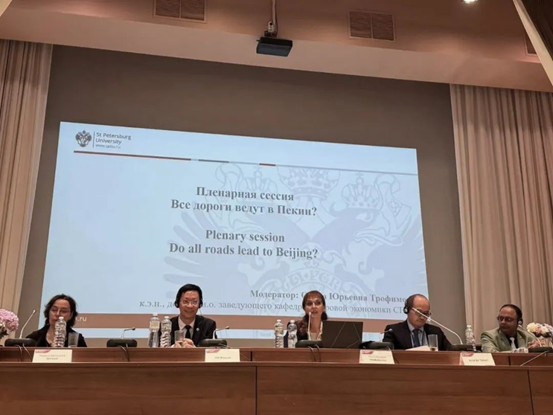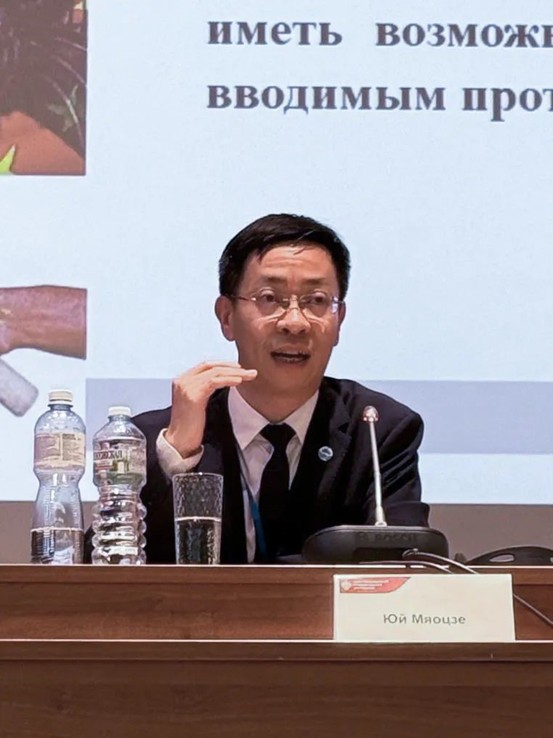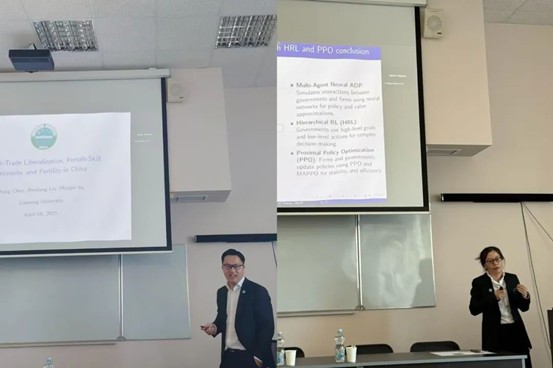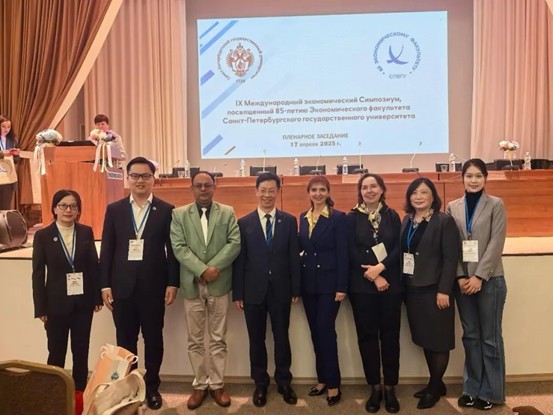From April 17 to 18, 2025, the 22nd International Conference on ‘The Evolution of the International Trade System: Prospects and Challenges’ was successfully held at Saint-Petersburg State University in Russia. Professor Yu Miaojie, a fellow of the International Economic Association and President of Liaoning University (LNU) was invited to attend the conference and delivered a keynote speech. Dr. Liu Renliang and Dr. Wang Dandan, assistant professors at the Li Anmin Institute of Economics also participated in the conference and gave academic reports at the sub-forums.

The conference has been successfully held for 22 consecutive sessions, aiming to bring together global experts, scholars and professionals in practical fields to discuss the key issues and future developments in the evolution process of the international trade system. This year’s conference is also one of the commemorative activities for the 85th anniversary of the establishment of the Faculty of Economics at Saint-Petersburg State University. The goal of the conference is, against the backdrop of the current complex and changing geopolitical situation and the global economic transformation, to analyze the practical challenges and future trends faced by the international trade system and to promote global economic cooperation and institutional innovation.
2025’s conference was hosted by the Department of World Economy of Saint-Petersburg State University and received support from institutions such as the Department of Economics of Saint-Petersburg State University, the Institute of World Economy and International Relations of the Russian Academy of Sciences and the International Energy Business School of the Russian State University of Oil and Gas. Keynote speakers included Olga Y. Trofimenko, Head of the Department of World Economy at Saint-Petersburg State University, Debasish Nandy, a professor from the Department of Political Science at Kazi Nazrul University in India, Vu Thang Pham, former Director of the Center for Economic Development Research at Hanoi National University in Vietnam, Luidmila V. Popova, a professor from the Department of World Economy at Saint-Petersburg State University and other internationally renowned scholars. The conference accepted nearly a hundred high-level papers from scholars from multiple countries, including Russia and China.
In the keynote speech session, Yu Miaojie pointed out that in 2024, China’s GDP reached 134 trillion yuan, contributing 30% to global growth. To achieve a growth rate of 5%, China will expand domestic demand through proactive fiscal policies and prudent monetary policies and stimulate consumption and investment through tax cuts and fee reductions as well as interest rate cuts. In the medium to long term, China is transforming from high-speed development to high-quality development, adhering to the new development concepts of innovation, coordination, green development, openness, and sharing. The proportion of R&D investment in GDP is 2.68%; China has pledged to reach its carbon peak before 2030; it is promoting coordinated urban-rural development and common prosperity; and adhering to a comprehensive opening-up strategy with a larger scale, broader scope, and deeper level. Through export diversification, expanding imports, developing service, green, and digital trade, optimizing the business environment, attracting foreign investment and encouraging outbound investment, China is deepening institutional opening-up to enhance its global competitiveness. Regarding the trade war initiated by the United States, he pointed out that the U.S. argument of using tariffs to reverse the trade deficit is out of touch with reality. He emphasized that China’s trade surplus stems from its comparative advantages. China-US trade only accounts for 10% of China’s foreign trade, and extreme tariffs are unlikely to shake the foundation of China’s foreign trade. China is confident to respond calmly. Regarding cooperation with countries in the Global South, he believes that China’s huge market and complete industrial chains create huge import demands. The Belt and Road Initiative supports infrastructure construction without any additional constraints. Outbound investment creates jobs and promotes technology transfer in labor-intensive fields, providing countries in the Global South with a new model of modernization. In terms of economic and trade cooperation between China and Russia, he suggested strengthening strategic coordination, optimizing the bilateral investment and trade environment, and promoting local currency settlement and educational cooperation. During the interaction, he reviewed the evolution of China’s urbanization process from the development of large metropolitan areas to the revitalization of counties, emphasizing that urbanization and industrialization must be promoted simultaneously. He believed that China and the United States should jointly expand the mutual economic benefits and expressed his firm confidence in China’s economic development with the courage to move forward continuously.

At the sub-forum on Economic Transformation in Asia and Latin America, Liu Renliang introduced to the participants his co-authored paper with Yu Miaojie and Chen Feng, titled ‘Import Intermediate Goods Trade Liberalization, Female Skill Intensity and China’s Fertility Rate’. He pointed out that the interaction between trade liberalization and population behavior reveals the challenges faced in balancing career development and family life. The paper adopted the Bartik-style shift-share instrumental variable strategy and incorporated female skill intensity into the calculation of input tariff exposure. The study found that input trade liberalization significantly reduced the fertility rate, especially among highly educated women, employees in the private sector, and first-time mothers, with these groups facing the most severe trade-offs between career and family. The mechanism analysis showed that the improvement of labor market prospects had increased the opportunity cost of childbearing, thus delaying or reducing family formation. The research results highlight the economic impact of trade policies on population trends and provide an important reference for relevant policy-making.

At this sub-forum, Wang Dandan introduced to the participants her co-authored paper with Yu Miaojie, titled ‘The Power Game of Trade: Multi-level Governments and Heterogeneous Enterprises’. She pointed out that in the context of globalization, the dynamics of international trade are becoming increasingly complex and traditional economic models find it difficult to comprehensively capture the relatively complete government structure, enterprise heterogeneity, and strategic policy interactions. To this end, she proposed an innovative methodological framework and combined multi-agent reinforcement learning technology with economic modeling. In her report, she elaborated in detail on the key features of the model, including the government structure of the exporting country, the Pareto distribution of enterprise productivity, the endogenous capacity utilization rate, as well as the strategic policy interactions among all parties. The model used reinforcement learning algorithms to simulate the adaptive behaviors and strategic choices of governments and enterprises in a dynamic trade environment. It particularly revealed how coordination among governments affects the efficiency of subsidies, and this finding was of great significance for understanding policy-making under a complete government structure, providing policymakers with new analytical tools.

During the conference, Otar L. Margania, Dean of the Faculty of Economics at Saint-Petersburg State University in Russia, which was the organizer of the conference, and his team members had exchanges with Yu Miaojie and his team members on scientific research and teaching cooperation.